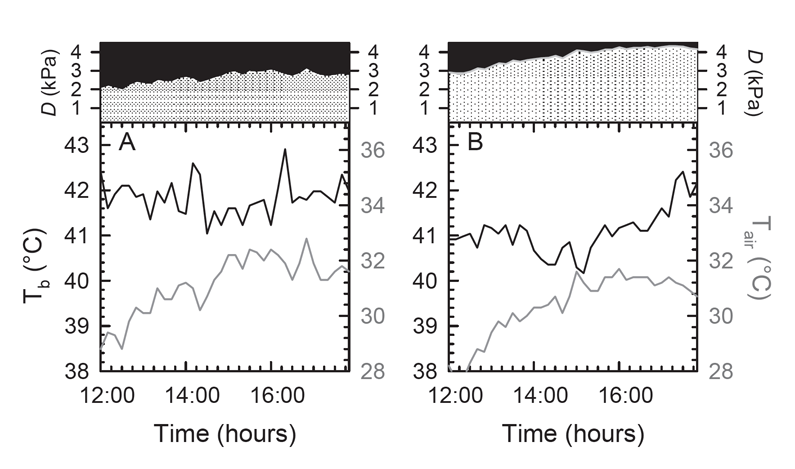
Ecological Archives --A2
B. Smit, C. T. Harding, P. A. R. Hockey, and A. E. McKechnie. 2013. Adaptive thermoregulation during summer in two populations of an arid-zone passerine. Ecology 94:1142–1154. http://dx.doi.org/10.1890/12-1511.1
Appendix B. Additional figures on body temperature and behavior patterns of White-browed Sparrow-Weavers (Plocepasser mahali).
Fig. B1. Representative traces of vapor pressure deficit (D - top panels), body temperature (Tb, displayed on left y-axes by black line) of a White-browed Sparrow-Weaver (Plocepasser mahali) and air temperature (Tair, displayed on right y-axes by gray line), between 12:00 and 18:00 hours on (A) a humid day (mean dew point = 16.1°C) and (B) a dry day (mean dew point 1.7°C) at Wildsgenot Game Ranch (desert). On humid days, Tb was generally higher. The top panels display water vapor pressures (kPa); the black area is an approximation of the absolute humidity (saturation vapor pressure was between 4.2 and 4.5 kPa), and the hatched area indicates D.
Fig. B2. Behavioral responses to air temperature (Tair) by White-browed Sparrow-Weavers (Plocepasser mahali) between 12:00 and 18:00. The majority of these observations were recorded during January and February 2011 in Tswalu Kalahari Reserve (semi-desert site, wet season). The proportion of time spent resting or foraging during focal observations varied as a function of air temperature (Tair) between (A) early(12:00 – 14:00 hours), (B) mid (14:00 – 16:00 hours), and (C) late (16:00 – 18:00 hours) afternoon (PM). Proportion of time spent foraging in shade or sun also varied as a function of Tair between (D) midday, (E) afternoon, and (F) evening. A logistic curve indicates a significant trend.